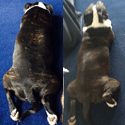Teach Your Dog to Stop Pulling on the Leash
Teach Your Dog to Stop Pulling on the Leash
To begin with, I say "loose-leash walking," or "polite leash walking," not "heeling." Heeling is a formal competitive exercise, with the dog close to the handler's left leg and attentively turned toward her. It's not appropriate for an hour's afternoon stroll: for starters, if you're the dog, never being allowed to sniff pretty much defeats the purpose of the walk. For a pleasant walk from your end, all you really need is for the leash to remain slack and for your dog to attend to you enough to turn with you and stop when you do. To me, a walk with my dog feels like holding hands.
The catch is, loose-leash walking may be the hardest behavior for you to teach and for most dogs to learn. But it doesn't have to be that way with the proper guidance.
Factors That Make Loose-Leash Walking Difficult
To begin with, it's unnatural. When was the last time you saw a couple of off-leash dogs walk parallel to each other, in a straight line, for more than about two feet? Our species don't even move the same way. Humans walk; healthy, active dogs who arenít tired are more inclined to trot. The human and canine agendas diverge, too. We want to get from place to place and maybe get some exercise; they just want to chase squirrels and smell lamp posts.
Another factor has a technical name: random, variable reinforcement. It means this. When a behavior works occasionally, and you can't predict exactly when, you will try it over and over and over and over again. And you will not give up trying it for a long time even after it stops working. For you and your dog, this means that whenever you let her drag you toward another dog or an interesting pee spot, you've built a little more staying power into her attempts to pull.
Finally, like many animals, dogs reflexively oppose restraint. Common sense suggests that if you're living in the wild, this is a good way to improve your odds of surviving to reproduce. So, when the leash tightens and the collar presses against the dog's neck, her natural tendency is to pull harder. That may be one reason for the sad spectacle of a dog pulling as hard as she can against a choke collar, coughing all the while.
Be an effective Teacher
You may now be thinking all is lost. Not so! Hereís how to become a more effective teacher for your dog.
Remember to set the dog up to succeed in your goal of loose-lead-walking. There is no point in taking the dog outside for a walk if he is excited or anxious. So you need to get the dog in the correct frame of mind. You will need to lead by example here; if you are going to the dog in an excited manner 'ARE WE GOING FOR A WALK!'. Then the dog is going to be wired to the moon and be like a race horse out of the gate and you are going to be fighting against your dog for the whole walk and thus resulting in a stressful unpleasant experieince for everyone. Take a few minutes to get you and your dog in a calm relaxed frame of mind and once this is acheived then you can start the walk.
Another thing I'd suggest to all dog owners when you are out on a walk with your dog - be with your dog! What I mean here is take the time out of your dog to give the dog your attention. For a lot of owners walking the dog is a chore, but for your dog it is the highlight of her day. She is getting to do what she loves most with the person she loves the most. So stop texting and calling on your phone. Be in the moment with your dog because your dog knows you are not really there with them and it does affect them.
Tools and how to use them
I prefer to use a slip leash as this give you the ultimate control and two-way communication with your dog. Place the slip leash high on the neck behind the ears and in doing this it is only a matter of slight jerks on the lead for an effective correction and always keeping the dog next to you and walking in a straight line on a short loose lead.
The key to a successful walk
The key to a nice relaxing walk is not the correct tools or the right frame of mind, though these things need to be applied. The key is persistenct. If you have a dog who pulls on the lead it is peristance and training that will change the dogs behaviour. It will take time to change the dogs way of walking. For with most dogs this is a behaviour pattern that has been built up over it's entire life and changing lifetime behavour patterns takes time. But within a relatively short period of time you and your dog can be enjoying a relaxing walk together that will make the walk a stress buster. Rather than a source of stress.







